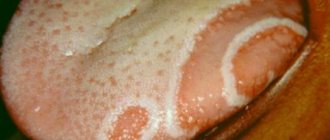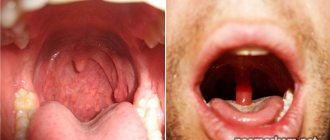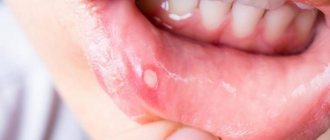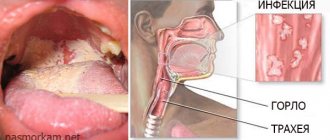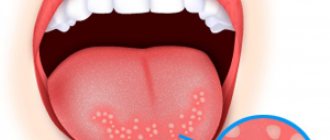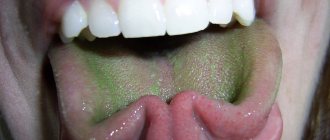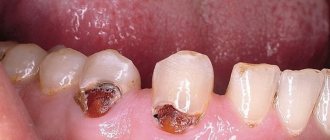How to identify bad breath?
It's not always easy to detect an unpleasant odor. Often others hear it, and we, in turn, may not be aware of such an unpleasant symptom. There are several ways to check the freshness of your breath. You can carry out tests: with a plastic spoon and napkin:
- remove plaque from the back of the tongue using a spoon;
- wait 1 minute;
- evaluate the smell from a spoon.
You can also remove plaque from your tongue using a sanitary napkin:
- stick your tongue out, holding it by the tip;
- wipe the back with a napkin;
- After 45 seconds, detect the presence of odor.
These tests will help identify the source of the triggering microbes and the stomach disease.
Types of odors and their meaning
There may be odor coming from the mouth due to various diseases:
- hydrogen sulfide breath, reminiscent of the smell of rotten eggs, caused by gastritis with high acidity or atrophic gastritis;
- rotten smell, occurs with acute gastritis, after eating there is heaviness in the stomach or mild pain that lasts 10 - 15 minutes;
- a sour smell, indicating the presence of an ulcer or pancreatitis, accompanied by abdominal pain, weakness, loss of appetite;
- putrefactive breath is a problem with the esophagus or intestines and may be accompanied by diarrhea, fever, coating on the tongue and vomiting;
- pain in the stomach and the smell of laundry soap from the mouth, which is caused by constant overeating, accompanied by belching, poor sleep, and a yellow coating on the tongue;
- the smell of feces indicates dysbacteriosis and intestinal obstruction.
Important! If you notice persistent bad breath, consult a doctor immediately.
What gives the yellow-green color to purulent sputum?
The respiratory organs are an open system of tubes devoid of valves, membranes, sphincters, etc. The air we breathe contains microorganisms in addition to organic and inorganic dust. These are viruses, bacteria, fungi. Once inside the respiratory system, they can be removed from it with the help of mucus and villi. In this case, a person will not even feel the presence of foreign objects in the bronchi. But during illness, microbes gain an advantage, multiply quickly, and come into conflict with the human immune system. They die, the protective cells die, and the surrounding tissue is damaged. Complex cytotoxic reactions occur. All these “military” actions lead to a change in the color of sputum. The more pronounced the inflammation process, the more purulent the sputum will become. In chronic long-term processes, sputum acquires a green-brown character and becomes viscous. In this case, the patient may cough up sputum in the form of casts of the bronchi. Green color.
The purulent nature of sputum can occur in acute and chronic lung diseases. In any case, this symptom cannot be ignored. Treatment measures must be carried out quickly and effectively.
Sputum interspersed with dark gray lumps may indicate mold growth or a tuberculosis infection.
The canary-colored sputum is characteristic of pulmonary aspergillosis.
Klebsiella pneumoniae causes a cough with sputum the color and consistency of “raspberry jelly.”
Yellow sputum is characteristic of acute diseases caused by Staphylococcus aureus, streptococci S. pneumoniae, S. pyogenes. Such sputum can occur in any pulmonary disease from acute bronchitis to pneumonia.
Green sputum is more typical for chronic lung diseases; this may be bacterial associations of gram-positive and gram-negative bacteria. Such as Haemophilus influenzae + Staphylococcus aureus. Or Pseudomonas aeruginosa P. aeruginosa in combination with streptococci. Occurs in patients with bronchiectasis, COPD, and cystic fibrosis.
Thick green sputum with an odor indicates a lung abscess, abscess pneumonia. Pathogens can be S. aureus, K. pneumoniae, gram-negative bacilli, Streptococcus pyogenes Haemophilus influenzae.
The presence of blood in the sputum may indicate a pulmonary embolism, cancer, or problems with the larynx.
What to do?
In acute diseases, purulent sputum does not appear immediately, but usually on the 4th day of the disease. If coughing up such sputum is accompanied by an increase in body temperature, then the help of a doctor is necessary. No need to self-medicate!
In COPD, bronchiectasis, and obstructive bronchitis, sputum may become purulent within one to two days. Often green-yellow color of sputum is constantly present in a person suffering from chronic pulmonary diseases. During exacerbations, it becomes intensely green and coughs up large quantities. Patients with chronic lung diseases should have an individual plan prescribed by a pulmonologist for preventive and urgent action in connection with the appearance of purulent sputum. If you do not have such a plan, remind your doctor that you need one. If your active actions do not help within 5-7 days, contact a pulmonologist.
Diseases characterized by purulent sputum
- COPD,
- Bronchiectasis,
- Pneumonia,
- Chronic purulent obstructive bronchitis,
- Lung abscess, abscess pneumonia,
- Pulmonary tuberculosis,
- Cystic fibrosis,
- Purulent processes in the nasopharynx,
- Pulmonary aspergillosis,
- Non-tuberculous mycobacteriosis.
Diagnostics
Diagnosis of diseases of the respiratory organs leading to expectoration of purulent sputum is a set of measures that includes examination, auscultation, and percussion of the chest.
Mandatory x-ray examination. Computed tomography of the chest organs (CT CT) is considered more informative.
Functional breathing tests - respiratory function, body plethysmography and diffusion tests are often necessary.
Sputum examination is an important stage for prescribing treatment and assessing the prognosis of the disease. Routine sputum tests are important to assess the severity of inflammation (by counting the number of leukocytes in the sputum) and eosinophils. A general sputum test can help identify Mycobacterium tuberculosis. Fragments of mycelium or pseudomycelium of fungi.
The microbiological method (sputum culture) answers the question of what is the name of the microorganism that causes purulent, mucopurulent inflammation in the lung tissue. The sputum is sown on special nutrient media, the colony is counted and the name of the pathogen is determined. Detection of H. influenzae, M. catarrhalis and S. Pneumoniae.
For example, risk factors for Pseudomonas infection include recent hospitalization (2 days within the past 90 days), frequent use of antibiotics (4 courses within the past year), severe COPD, isolation of P. aeruginosa during a previous exacerbation, stable period of Pseudomonas colonization, and systemic use of glucocorticoids.
It will require the prescription of antibiotics aimed at destroying these particular microorganisms.
How can we help?
First, it is necessary to treat the disease leading to cough with purulent sputum. Be it an acute or chronic disease. The presence of hemoptysis is an urgent reason to consult a doctor.
- If the disease is caused by bacterial flora, then antibacterial drugs are prescribed.
- If we are dealing with influenza and bacterial pneumonia that has developed against it, a combination of antiviral drugs and antibiotics is needed
- If the cause of purulent sputum is a fungal infection, then it is necessary to treat with antifungal drugs
- If tuberculosis is detected, then use anti-tuberculosis drugs.
For a rapid response to treatment, bronchoscopy may be effective. These are manipulations in which a flexible endoscope is inserted into the bronchus, which sucks out purulent sputum from the bronchi, and with the help of it you can pour an antiseptic and antibiotic into the bronchus. But the method is traumatic, unpleasant and dangerous with complications.
An alternative to bronchoscopy can be considered hardware coughing technologies - intra-alveolar percussion devices, vibration vests, exercise therapy sets, breathing simulators and coughers for home use.
How to get rid of unpleasant odor from the stomach?
Regardless of the degree of stomach disease, odors appear due to the proliferation of bacteria. Following some tips will help you get rid of them.
To do this, you need to use cleaners that reduce the activity of sulfur compounds that cause unpleasant odors.
The cause of unclean breath must first be determined. The main reason is a coating on the tongue, which reveals stomach diseases, in particular gastritis of various forms. Treatment can be carried out with medication, following a diet and folk remedies.
Tablets for bad breath
To get rid of unpleasant odor from the stomach, you need to act comprehensively. First, try to eliminate the symptom first, as this is much faster than eliminating the cause. Then you should deal directly with the source of the disease, and this is much more important. So, what pills will help with bad breath?
The following drugs are prescribed by doctors to quickly relieve symptoms:
- Septogal - this combined drug acts as a detergent, catalytic, eliminating unclean breath.
- Asepta , freshens breath, contains mint essential oil, menthol, in addition to removing odor, kills pathogenic microbes, as it contains the antiseptic chlorhexidine.
- Infresh , a concentrated preparation for resorption, contains alfalfa, wheatgrass, mint, the active ingredient is chlorophyll, anti-inflammatory and antioxidant.
- Hydrogen peroxide 3% for rinsing the mouth, eliminates anaerobic bacteria, washes away plaque from the tongue. Use: 1 tsp. per glass of water.
Important! It is worth noting that you should not resort to using chewing gum to freshen your breath. This will only make things worse. Due to the release of gastric juice, the degree of impact on the stomach walls will increase. And this, in turn, will only provoke peptic ulcer disease and the development of gastritis.
Tablets to treat the cause of stomach odor:
- Biovestin-Lacto removes putrefactive, pathogenic microbes and restores the microflora of the stomach.
- Activated carbon , 1 tablet after meals, three times a day.
- Enterosgel - serves as a powerful sorbent, cleanses the walls of the stomach from pathogenic flora.
- Ranitidine - used for gastritis, peptic ulcers and stomach pain. Serves as protection against the destructive effects of hydrochloric acid.
- Omeprazole - blocks the increased secretion of hydrochloric acid.
But it is important to remember that an unpleasant odor is only a signal that pathological processes are developing in the body. Therefore, simply eliminating an unpleasant symptom will be wrong; it is important to identify the cause and fight it.
Diet
What is a diet that allows you to get rid of unpleasant odor? Doctors recommend excluding:
- consumption of sugar in any form (tea, sweets, chocolate, etc.);
- coffee and black tea;
- reduce the amount of meat dishes;
- chips, fast food;
- fresh milk, cottage cheese.
It is more recommended to use:
- raw vegetables, berries, fruits;
- fermented milk products with acidophilic bacteria (yogurt, fermented baked milk, biolacts, etc.);
- a large amount of water (at least 10 glasses per day);
- dried fruits, as well as compotes made from them (dried apricots, prunes, raisins).
Metallic blood taste when coughing
Bloody taste is characterized by a metallic aroma in the mouth, which is a consequence of the rapid oxidation of fats with the participation of catalysts in the form of iron salts.
Causes of cough with iron taste
A cough that has a metallic taste is often not at all associated with a respiratory disease. This symptom can indicate many health problems, in a variety of areas. The glandular taste itself is one of the signs of blood in saliva, which may indicate the development of internal bleeding, and is additionally accompanied by the following symptoms:
- complaints of general weakness;
- drowsiness;
- pallor;
- dizziness.
It is possible that the body signals a lack of iron with a metallic taste in the mouth.
The reason for this phenomenon may be:
- The development of pathologies in the digestive system. The first suspicion falls on the presence of a gastric ulcer, which is accompanied by nausea and vomiting. There may be disruptions in the functionality of the pancreas or liver, which is characterized by increased fatigue, a feeling of bitterness in the mouth and nausea.
- For a runny nose and nasal congestion, if the patient has made a lot of effort to blow his nose and the capillaries have been damaged.
- When the body develops a deficiency of certain microelements/vitamins.
- When using certain medications.
- Installation of metal crowns by a dentist.
- The presence of iron deficiency anemia, which manifests itself as cracking of the tongue.
Treatment of cough that tastes blood
Treatment for such a cough can only be determined by a doctor, having identified the provoking factor of the taste of blood in the mouth.
If the cause of coughing up blood is acute bronchitis, you should take medications to alleviate the cough, since a more serious course of the disease with purulent formations or lesions of a malignant tumor should require surgery.
When a cold develops or is affected by cough viruses with the presence of a bloody-metallic taste, a number of drugs in various dosage forms are used for treatment. You can expect the appointment of Bromhexine, Ambroxol, Herbion, Sumamed.
Treatment is often recommended to be supplemented with methods of traditional healers in the form of steam inhalations with the addition of essential oils. Herbal teas (sage, St. John's wort, linden) and drinking hot milk with the addition of honey and ginger have considerable benefits for treating cold coughs and softening the walls of the throat.
Prevention
Food consumed by a person with gastritis can cause bad breath. Poor nutrition includes fatty foods, smoked foods, and alcohol consumption. All this leads to negative consequences. In this case, you can fight bad breath in the following way:
- Use products containing mint, menthol and similar flavorings. Chewing gum, toothpastes, special oral sprays.
- Balance your diet, preferably including foods of plant origin.
- Stimulate the secretion of saliva, as it is a faithful assistant in restoring fresh breath. Drinking green tea, parsley, apples and orange will help with this.
How to remove unpleasant odor immediately?
What if a visit to your doctor is postponed for some reason, but you need to freshen your breath immediately? There are several options for this:
- eat fresh carrots or a juicy apple to remove plaque, and fiber will eliminate “smelling” substances in the stomach;
- chew fennel, parsley, anise or dill;
- rinse your mouth with an infusion of eucalyptus and sage; the effect will be slightly less from strong, freshly brewed tea, only without sugar;
- drink sorbents: enterosgel, polyphepan, etc.;
- use propolis tincture.
Other causes of bad breath
The reasons for the appearance of an unpleasant odor are not only due to gastritis or other gastrointestinal diseases. It may be associated with the activity of anaerobic microflora from the oral cavity, when sulfur compounds, organic acids, and amines are produced in the process of vital activity.
The reason for this is:
- plaque formation on teeth and interdental pockets;
- carious cavity;
- tartar;
- salivary gland disease;
- stomatitis, tooth abscess;
- diseases of the tongue, gums;
- incorrectly installed orthopedic structures;
- poor quality oral care;
- missing teeth and periodontal disease.
More serious diseases also cause formations of unclean breath. These include intestinal obstruction caused by a tumor, Crohn's disease, and postoperative scars. Sinusitis is another reason, accompanied by a poor sense of smell, runny nose, cough, provoked by excess mucus, pain, and fatigue.


